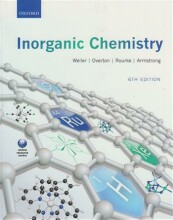Molecular symmetry - Symmetry adapted linear combinations
3 important questions on Molecular symmetry - Symmetry adapted linear combinations
What is the principle of the MO theory of diatomic molecules?
Identify the symmetry species of the SALCs that may be constructed from the H1s orbital of NH3
What is the general procedure for constructing a molecular orbital scheme for a molecule
2. Look up the shapes of the SALCs in resource section 5
3. Arrange the SALCs of each molecular fragment in increasing order of energy, first nothing whether they stem from s,p, or d orbitals. And then their number of internuclear nodes
4. Combine SALCs of the symmetry type from the two fragments and from N SALCs from N molecular orbitals
5. Estimate the relative energies of the MO from consideration of overlap and relative energies of the parent orbital and draw the levels on a MO energy-level diagram
The question on the page originate from the summary of the following study material:
- A unique study and practice tool
- Never study anything twice again
- Get the grades you hope for
- 100% sure, 100% understanding































